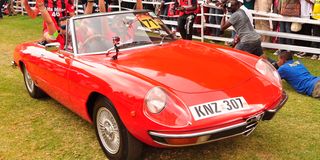Premium
At what point do cars become collectibles?

Anwar Fatehdin won the class for utility vehicles in the Africa Concours d’Elegance with his 1947 Ford V8 pick-up In 2019.
At what point do cars stop depreciating and start to appreciate on their way to becoming collectors’ items?
Max
Some “collectible” cars do appreciate with age, and may become worth many times more than their original brand-new price. What makes them collectible is their rarity, with either a classic status and/or remarkable condition for their extreme age. At peak, a car that is classic and ancient and perfect can be worth a not-so-small fortune. If it used to belong to someone super famous, then even more. Millions. Weird but true.
Generally, though, all cars depreciate from the moment they leave the showroom, at that instant, where they immediately become “not brand new”, depreciation is considerable. Thereafter they depreciate at a steady rate depending on their age and mileage, with either a premium or penalty if they are in unusually good or especially poor condition. All the way to the scrap-heap.

Judges assess the 1930 Ford Model A of John Wroe of Adrian Wroe during the 2022 Golden Africa Concours at Ngong Racecourse on September 25, 2022.
Many markets have widely published price lists for each year of each model of every make. Those prices are based on, and in turn influence, actual transaction prices. Free market forces also play a part at both ends of that system, so there is no universal depreciation rate. How fast and how far progressive reduction in value goes depends on the reputation of and popular demand for the model concerned, and whether it is a cheaply made and lightly-built little car with a relatively short “economic design life”, or a more robustly constructed heavy-duty or prestige vehicle (for instance a big-engined 4WD Estate).
The limo anomaly
High-prestige saloons and limousines are an anomaly. Although they have a very high showroom price and a very much longer potential design life, their running costs and parts prices are prodigiously high. People who can afford that can afford a new car. In the used car market, people who can’t afford their running costs don’t buy them, so their resale value plummets.
Condition matters and mileage matters, as does provenance (the car’s ownership and usage history) but it is not fundamental to the core list price. There is usually a close correlation between age and mileage in a privately owned car. The lists give a spread of value based on A, B or C condition, in which exceptionally low or high mileage can be considered as a factor.

A 1972 Alfa Romeo 2000 Spider Sports car.
When old cars become ‘runners’
The lists do not go back down the years for ever. The “economic design life” bar in most markets is set at around 10 to 15 years, and after that they are not known as X-year-olds but as “runners”. Age and mileage cease to dominate, and viable condition becomes the primary measure.
Also read: Who will influence your next choice of car?
If one or more owners keep them going well for a decade or more after that, and they have other attributes that make them collectible (for the reasons given) that is when the value can start to rise. Ultimately, progressive age that has depreciated their value now starts to add to their value! If they are the right stuff.
Cars over 30 years old can be classified as potential “modern classics”. Cars built between 1950 and 1969 qualify as “Classic”. Between 1931 and 1949 they are “Post Vintage”. From 1919 to 1930, they are “Vintage”. If manufactured prior to 1918 they are “Veteran”. Kenya has quite a few examples in all but the Veteran category.
“Collector’s items” that can be worth huge amounts of money are usually in perfect (even better-than-new) condition. Old wrecks with that potential are also in demand (a price factor) but restoring them can cost a fortune so, by the time they qualify for sale on millionaire’s row, they need to have a price tag studded with diamonds.
***
Do you have a motoring question? Email [email protected]





